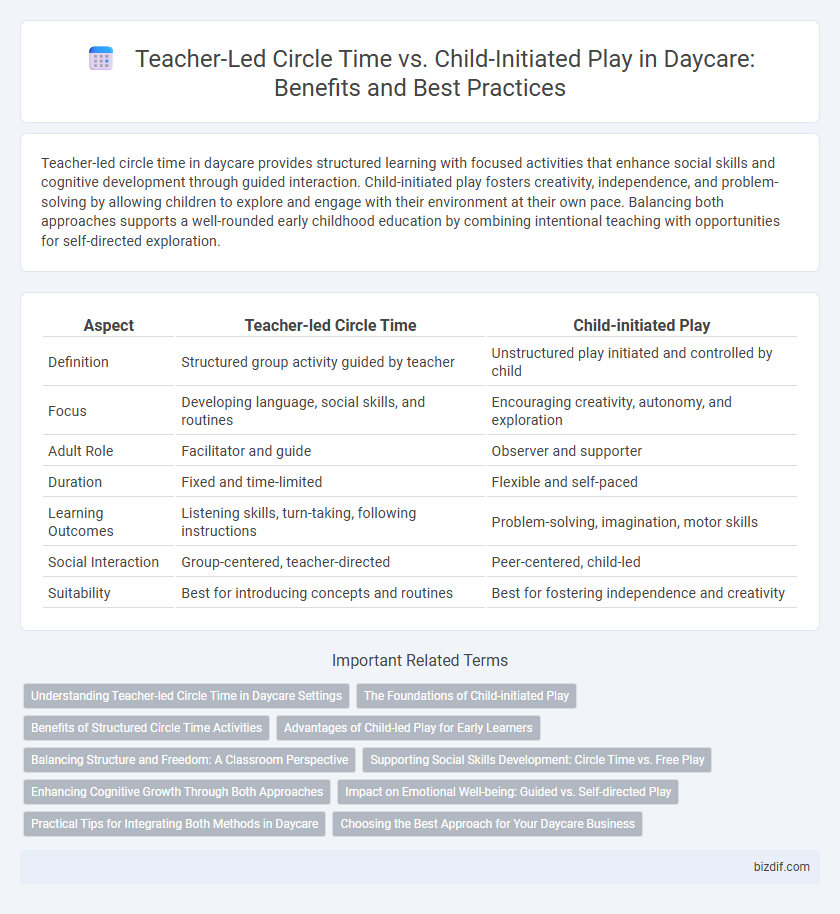Teacher-led circle time in daycare provides structured learning with focused activities that enhance social skills and cognitive development through guided interaction. Child-initiated play fosters creativity, independence, and problem-solving by allowing children to explore and engage with their environment at their own pace. Balancing both approaches supports a well-rounded early childhood education by combining intentional teaching with opportunities for self-directed exploration.
Table of Comparison
| Aspect | Teacher-led Circle Time | Child-initiated Play |
|---|---|---|
| Definition | Structured group activity guided by teacher | Unstructured play initiated and controlled by child |
| Focus | Developing language, social skills, and routines | Encouraging creativity, autonomy, and exploration |
| Adult Role | Facilitator and guide | Observer and supporter |
| Duration | Fixed and time-limited | Flexible and self-paced |
| Learning Outcomes | Listening skills, turn-taking, following instructions | Problem-solving, imagination, motor skills |
| Social Interaction | Group-centered, teacher-directed | Peer-centered, child-led |
| Suitability | Best for introducing concepts and routines | Best for fostering independence and creativity |
Understanding Teacher-led Circle Time in Daycare Settings
Teacher-led Circle Time in daycare settings establishes structured opportunities for social, cognitive, and language development by guiding children through focused activities like storytelling, songs, and discussions. This practice supports early learning objectives and helps children develop listening skills, turn-taking, and group participation crucial for school readiness. Consistent implementation of teacher-directed interactions during Circle Time enhances attention spans and fosters a sense of community among preschool-aged children.
The Foundations of Child-initiated Play
Child-initiated play forms the foundation of early childhood development by promoting autonomy, creativity, and cognitive growth through self-directed exploration. Unlike teacher-led circle time, this approach engages children in activities that reflect their interests, fostering intrinsic motivation and social-emotional skills. Research shows that environments rich in child-initiated play encourage problem-solving abilities and language development critical to long-term academic success.
Benefits of Structured Circle Time Activities
Structured circle time activities in daycare promote focused social interaction and enhance language development by providing a guided setting for children to practice communication skills. These teacher-led sessions support cognitive growth through organized learning themes, encouraging attention and memory retention. Consistent routines during circle time foster emotional regulation and a sense of security, aiding in the development of classroom behavior and cooperation.
Advantages of Child-led Play for Early Learners
Child-initiated play fosters creativity and autonomy, allowing early learners to explore interests at their own pace and develop critical problem-solving skills. This play style promotes social collaboration, as children negotiate roles and practice communication in natural interactions. Research shows that child-led environments enhance motivation and cognitive growth more effectively than structured teacher-led activities.
Balancing Structure and Freedom: A Classroom Perspective
Balancing structure and freedom in daycare classrooms involves integrating teacher-led circle time with child-initiated play to support developmental milestones and social skills. Teacher-led circle time provides essential routines, guided learning, and group interaction, fostering language development and attention skills, while child-initiated play encourages creativity, independence, and problem-solving. Research indicates that a hybrid approach maximizes cognitive and emotional growth by meeting children's needs for both adult guidance and autonomous exploration.
Supporting Social Skills Development: Circle Time vs. Free Play
Teacher-led Circle Time fosters social skills by guiding children in turn-taking, active listening, and group communication, creating a structured environment for practicing these abilities. Child-initiated Play encourages spontaneous social interactions, problem-solving, and collaboration, allowing children to develop social skills organically through peer engagement. Balancing Circle Time and Free Play maximizes social development by combining adult-led skill-building with opportunities for independent social exploration.
Enhancing Cognitive Growth Through Both Approaches
Teacher-led Circle Time structures learning with focused activities that boost language development, memory, and social skills through interactive storytelling and group discussions. Child-initiated Play allows children to explore their interests, fostering creativity, problem-solving, and decision-making abilities in a self-directed environment. Combining these approaches supports comprehensive cognitive growth by balancing guided learning with independent discovery.
Impact on Emotional Well-being: Guided vs. Self-directed Play
Teacher-led circle time provides structured social interactions that help children develop emotional regulation and empathy through guided discussion and shared activities. In contrast, child-initiated play fosters self-expression and autonomy, allowing children to explore emotions at their own pace, which enhances emotional resilience. Balancing guided circle time with opportunities for self-directed play promotes comprehensive emotional well-being in early childhood development.
Practical Tips for Integrating Both Methods in Daycare
Balancing teacher-led circle time with child-initiated play in daycare enhances developmental outcomes by combining structured learning with creativity and autonomy. Implement practical scheduling strategies such as allotting specific time blocks for guided activities focused on literacy and social skills, followed by open-ended play sessions that encourage exploration and self-expression. Incorporate flexible transitions between these methods to maintain engagement and support individual learning styles, optimizing both cognitive and emotional growth.
Choosing the Best Approach for Your Daycare Business
Teacher-led Circle Time fosters structured learning, promoting social skills and cognitive development through guided activities and group discussions. Child-initiated Play encourages creativity, independence, and problem-solving by allowing children to explore interests at their own pace, enhancing engagement and emotional growth. Balancing these approaches based on your daycare's educational philosophy and children's needs ensures optimal developmental outcomes and parent satisfaction.
Teacher-led Circle Time vs Child-initiated Play Infographic

 bizdif.com
bizdif.com